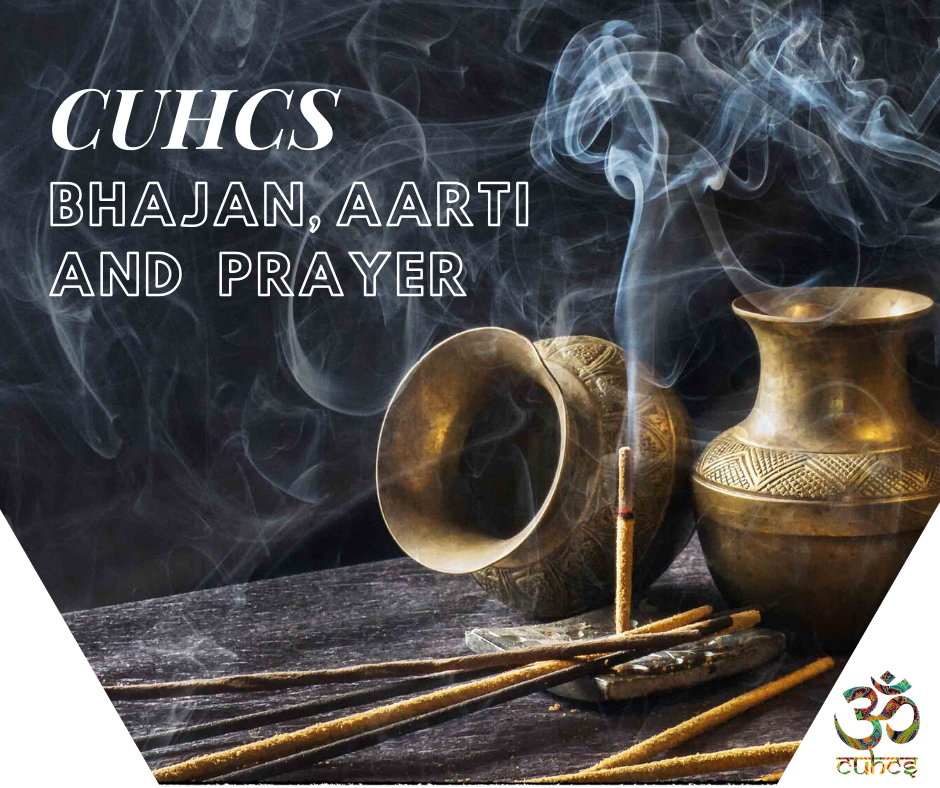
Join us on Saturdays at 7pm for a session of prayers, discussions, of course our aarti, and more, where everyone is welcome.
These weekly Satsangs are a wonderful chance to reflect and take a break from the hectic and busy world that we find ourselves in every day. Our Satsangs are a chance to remind ourselves of Bhakti and Dharma, such spiritual virtues that are often lost and forgotten on a University campus. Whether you are new to this sort of thing or not, we hope to be able to welcome you soon!
Satyam Shivam Sundaram
Thomas Awad, CUHCS Representative
Meeting Details
The sessions are held over Zoom. If you have a quiet prayer room this will be an ideal place to join for the sessions. If not, simply have a murti in front of you whilst we pray or join us as you are. Also, if you have an aarti or any source of light to conduct the aarti, this would be ideal. Please use whatever you have in this lockdown period, the most important thing being clarity of mind.
Click here to join our Facebook group and receive the Zoom link.
The Importance of Aarti
From our parents, to our grandparents, to the start of the age of Kalyug itself, aarti has been a prominent ritual performed Hindus all around the world.
It is a beautiful form of devotion where we light a diya (usually a clap lamp filled with ghee) and perform a clockwise rotation of the diya in front of a murti (a statue of a deity) or a respected individual as a sign of adoration, respect and love (bhakti).
The light of the diya symbolises the vanquishing of darkness in the presence of light. Light reflects knowledge, for the great intellectuals of this world would have no knowledge if they did not know where to look, if light was not shone on their intellectual path.. Knowledge over ignorance is like walking on a lit path over a dark one. Even in western traditions, the advent of an idea is associated with a light bulb.
In addition, the diya is one of the few material paraphernalia of this world that defies gravity. The defiance of gravity signifies the rising of an individual’s state of mind above and beyond the shackles that this world of maya (illusion) imposes on us.
The clockwise rotation performed around a murti or individual carries with it an immense amount of respect for that deity/individual. When we perform aarti, the light of the diya reflects through the visage of the deity and we ask them to please bless us with your wonderful qualities that this diya in my hand is currently highlighting.
The clockwise movement is associated with asking for something in expectation of a gain and an anticlockwise movement is when we want something removed. That is why when some of our aunties say we have nazar (evil eye) they take salt in their hand and rotate it around us anti-clockwise.
The singing of the aarti is beautiful in and of itself. Please join the Satsang to find out what it means!
The Importance of Bhajan and Satsang
Sat in Sanskrit means truth. Satsang is the association of like minded people for the seeking of the truth – the ultimate truth being that of paramaatma (Bhagwan). My Guruji always used to tell me:
Satsang Se Laab Hota Hain Aur Kusang Se Haani
I took this to mean that out of Satsang you will always get good things but when we indulge ourselves in bad company we will cause damage to ourselves. It seems straightforward but there are so many of us who forget this simple teaching. The best company is that with which we are all congregated together for the love of Bhagwan and community as a result. Life is too short for hatred and gossip.
Whilst the teachings of Hinduism can be learnt online in today’s age, the benefit of Satsang is the ability to bounce off of one another’s energy and to learn from each other’s experiences. In the olden days, scriptures and teaching used to be taught through word of mouth – this is the meaning of Upanisad and this was seen as one of the greatest forms of learning.
Satsang is not simply the congregation of many people to chant the name of the lord, it is when you are in the company of at least one good person. Whilst they might not be directly talking about god, their aura is exposing a godlike impression on you and when you finish the Satsang you feel enlightened.
The onset of the COVID-19 pandemic has made Satsang harder but the concept still remains the same. For some, you do not need to be talking to one another face to face in order to receive the nectar of the association. And yet for some, you do not even need to see or talk to one another to feel each other’s energy. Just like how a mother from India sends her asirvaad (blessings) to her son in the UK through a simple thought in her mind, love and teachings can transcend continents also.
The singing of bhajans (devotional songs) beautifully complement the katha (teachings) of a Satsang. There are many ways in which individuals can express their love for Bhagwan or their appreciation for the deities in Hinduism. One method may be the chanting of mantras, another may be to read the holy stories of the Ramayan and Mahabharat but another may be to sing about the grace of the lord. When one feels the beauty of a bhajan, it is one of the most beautiful experiences one can have – it is said to be the quickest way to a devotee’s heart.
In short, Bhagwan gave us these eyes to look at good things, this mouth to say good things and sing her/his name and these ears to listen to good things which can only be done through Satsang.